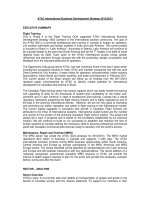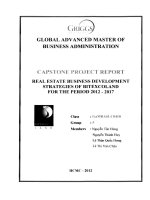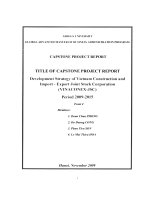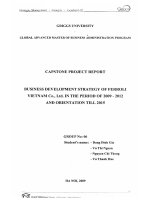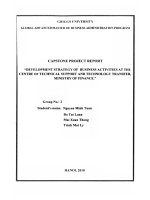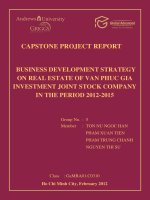BUSINESS DEVELOPMENT STRATEGY OF FERROLI VIETNAM
Bạn đang xem bản rút gọn của tài liệu. Xem và tải ngay bản đầy đủ của tài liệu tại đây (889.03 KB, 73 trang )
BUSINESS DEVELOPMENT STRATEGY OF FERROLI
VIETNAM Co., Ltd.
ACKNOWLEDGEMENTS
We commit that the content of this assignment has not been submitted to any degree
granting program yet.
We pledge that this report is made of all four members’ effort. All the analysis
findings and conclusions except for certain quotations are born by the whole
group’s working results
Signature of members in the group:
TABLE OF CONTENTS
No.
Discription
Pages
INTRODUCTION
5
1
Necessity for studying the theme
5
2
Objective of studying the theme
5
3
Scope of study
6
4
Method of study
6
5
Practice meaning of the theme
6
6
Diagram of study
6
7
Content lay-out
7
CHAPTER I : THEORY BASIS
9
1.1
Concept of strategy
9
1.2
Roles of strategy
9
1.3
Strategic planning
9
1.4
Strategic planning process
9
CHAPTER II:
INTRODUCTION AND ANALYSIS OF ACTUAL
COMPANY STATUS
27
2.1
Brief introduction about the Company
27
2.2
Analysis of external environment
27
2.3
Analysis of internal environment
37
2.4
2006-2009 Business Performance
43
2.5
Shortcomings and reasons
50
2.6
Building the Company’s development strategy
50
CHAPTER III: SUGGESTION or PROPOSED SOLUTION
51
AND CONCLUSION
3.1
Fundamentals of new business targets
51
3.2
Analysis and Selection of strategies
53
3.3
Solutions to implement strategies
66
3.4
Suggestion
69
3.5
Conclusion
70
Reference:
73
LIST OF TABLE
No
Discription
Pages
Table 1.1
Summary table of external business environment
17
Table 1.2
Summary table of internal business environment
18
Table 1.3
SWOT matrix
19
Table 1.4
QSPM matrix model
25
Table 2.1
Estimated total sales of the storage water heaters in 2008
35
Table 2.2
Total turn-over of the instant water heaters market in 2008
36
Table 2.3
Some achievement of Ferroli in the past few years
43
Table 3.1
SWOT matrix of Ferroli is described as follows
54
Table 3.2
QSPM Matrix of Ferroli Viet Nam Co.ltd.
61
LIST OF FIGURES & GRAPHS
No
Discription
Pages
Graph 0.1
Diagram of study
7
Graph 1.1
Analysis model of building and selecting strategies
10
Graph 1.2
Five - force model
13
Graph 1.3
Major strategic matrix
22
INTRODUCTION
1. Necessities for studying the theme.
For more than 20 years of renovation and integration into the world, Viet Nam has
been an active developing country. With the average growth of over 7% in the past
5 years, Viet Nam is considered to have a high growing rate in the region and in the
world.
The economic development not only brings out a large number of local and foreign
investment projects but also raises the demands for facilities of people, among
which water heater (For bathrooms) are
an indispensable need. Thus, many
enterprises including Ferroli Viet Nam Co., Ltd. have
imported, assembled and
distributed the water heater in the Viet Nam market.
Viet Nam has been fulfilling its commitments in the Asean Free Trade Agreement
(AFTA) together with regulations of World Trade Organization, bringing a lot of
opportunities as well as challenges for enterprises. As a result, the Company has to
determine its short-term and long-term development plan in order to take full use of
such opportunities and minimize the challenges to keep the business running and
developing. In this context, Group No. 6 decided to choose: “Business development
strategy of Ferroli Viet Nam Co.ltd in the period of 2009 - 1012 and the business
plan till 2015” as the theme of our graduation report.
2. Objectives for studying the theme
-
Enlighten the theory on business strategy and building business strategy to
the practice of Viet Nam Ferroli Co.ltd.
-
Clarify the relationship between business strategy and operation results.
-
Apply the theory on the building of business development strategies into
Ferroli Viet Nam Co., Ltd.
3. Scope of study
The theme takes Viet Nam Ferroli Co.ltd as an example for study. Due to lack of
time and other resources, our Group has focused merely on studying the business
development strategies of Ferroli.
4. Method of study.
Our Group has used the flowing methods in studying:
-
Historical materialistic dialectics.
-
Expert and direct investigation method.
-
Statistics and economic analysis method.
5. Practical meaning of the theme.
-
Systematizing, summarizing matters and methodologies about the business
development strategy and clarify all the specific characteristics of Ferroli
Viet Nam Co., Ltd.
-
Providing Ferroli with a panorama picture of its business environment so that
the Company’s Board of Management (BOM) can build up and choose an
optimal strategy to utilize its advantages and minimize it drawback to
achieve its short-term as well as long-term goals.
-
Making a contribution into the theoretical treasure of business development
strategy.
6. Diagram of study.
Graph 0.1
OBJECTIVES FOR STUDY
FIGURE COLLECTION
THEORITICAL BASIS
(PRIMARY AND
SECONDARY)
ANALYSIS OF
EXTERNAL
ENVIRONMENT
ANALYSIS OF
INTERNAL
ENVIRONMENT
SETTING AND SELECTING
STRATEGY
SOLUTION, SUGGESTION
AND CONCLUSION
7. Content lay-out.
Apart from the introduction, appendix and list of references, the assignment
structure is divided into three chapters.
Chapter I: Basis for theory
Theoretical fundamentals and concepts of strategic planning.
Chapter II: Analysis of Ferroli’s current status, business environment and the
Company’s development strategies.
-
Overview of the Company.
-
Operation results of Ferroli from 2006 to 2008 and the first 6 months of
2009.
-
Analysis of the internal environment so as to point out strengths,
shortcomings of the Company.
-
Analysis of the external environment in order to evaluate opportunities and
challenges of the Company.
-
Shortcomings and causes.
-
Business targets from 2009 to 2012 and development plan till 2015.
Chapter III: Solution, suggestion and conclusion
Represent solutions and suggestions to fulfill the selected business strategies
We have tried our best to study the theory and reality; however, due to lack of time,
references and survey together with the limitation of analyzing and consolidating
capability of the Group’s members, the assignment still has certain restrains. We
therefore would like to have comments and suggestions from the lecturers as well as
students in the class to make this graduation report better.
We are especially indebted to Mr./Mrs.…..who enthusiastically instructed and
supported our group during the time we conducted this presentation. Thank all the
members for their enthusiastic and timely collaboration to complete the report.
Appreciation is also expressed to the Board of Directors and employees in Ferroli
Viet Nam Co.ltd for their provision of important information and creating the most
favorable conditions for us to learn about the Company.
CHAPTER I
BASIS FOR THEORY
1.1 CONCEPT OF STRATEGY
According to Alfred Chadler, strategy is defined as the determination of basic and
long-term goals of an enterprise and a process of acting and distributing important
resources to reach these targets. There are various definitions of strategy which
share the same contents: Study the current and future market to point out objectives
for the Company. After that establish, perform and check the implementation of
decisions to fulfill those targets in the present-day and future environment
1.2 ROLES OF STRATEGY
Strategy plays a special important role in the operation of an enterprise. Strategy
also makes an organization more active in forecasting the environmental changes
then based on that to make control of its operation in the current market economy,
strategy helps to raise the competitiveness of the enterprises. An Enterprise that has
good strategies will have good business and vice versa.
1.3 STRATEGY PLANNING
Strategy planning is the first stage in the strategic administration. Strategy setting is
a process of setting up the business tasks, examining and reviewing the internal
strengths and shortcomings as well as the opportunities and the risks from the
external environment, establishing the long-term targets and building up and
choosing appropriate strategies.
1.4 STRATEGIC PLANNING PROCESS
The view of an individual or a team who determine the strategy, is considered to be
the most important factor in the establishment and selection of the strategies. This
factor is dependent on individual’s intuition, the analysis of which enables to
generate decisions about the establishment of appropriate strategies to the business
environment. In the fluctuating business environment, a good intuition and precise
vision will enable the enterprise to comprehensively analysis and approach the
business environment, find out the advantages and disadvantages that really affected
its operation to build up and implement the high feasible strategies which is suitable
to the environment and mission of the company.
Graph 1.1
Analysis model: building and selecting the strategies
Mission
Analyze the
external
environment
to find out
opportunities
and risks
Build up
strategies
Analyze the
internal
environment
to point out
strengths and
shortcomings
Select strategies
1.4.1 MISSION OF THE ENTERPRISE
Every enterprise organization has its own mission or task no matter they officially
announced or not. Generally, the founders and the leaders of enterprises shall
determine a mission to lead the company to fulfill certain targets. Defining the
current tasks, objectives and strategies of an enterprise is the first step in the
strategic management.
When the enterprise has developed and in the event of an extremely fluctuating
business environment, managers obviously realize that it is important for them to redetermine the initial goals, the aims of which are to:
-
Ensure that the enterprise’s objectives are suitable to the new situations and
missions.
-
Provide a base or standard to distribute the company’s resources.
-
Determine the enterprise’s objectives which will be evaluated and managed
by means of expenditure, time and operation parameters.
1.4.2 ANALYSIS OF EXTERNAL ENVIRONMENT.
The external environment which consists of a macroscopic environment and an
analytical sectorial environment enables to point out opportunities and threatens to
the company’s operation.
1.4.2.1 Macroscopic environment.
Due to constant changes of the local and foreign competitive market, the
determination of fluctuations of external factors is of great importance in the
strategy development of a company. The macroscopic environment includes
elements of economy, politics, society, nature and technology. The analysis of the
macroscopic environment supports the enterprise in defining opportunities and risks
to its operation in the future.
1.4.2.2 Economy.
Among different factors of the macroscopic environment, economy is considered to
be the most important. Economy puts direct impacts on the potential attraction of
various strategies. During the world economic crisis, Vietnam has still achieved the
positive growth rate in 2008 and early 2009. The unemployment rate slightly
increased due to the decrease in export, inflation rate and bank interest rate together
with demand stimulating policies of the government to encourage the investment in
infrastructure construction, social housing construction and consumer…might speed
up the domestic consumer to slightly increase. Export is decreased, it is time for
enterprises to focus on the domestic market.
1.4.2.3 Politics and law.
The stability or instability of the political institution and law is an important factor
that put impacts on both short-term and long-term plans of an enterprise. Vietnam is
looked at as a country with a stable politic environment, a safe place to invest with
the favorable conditions for penetrating into the Asean market and other countries
in the region.
1.4.2.4 Culture and society .
Changes in the culture and society include of: life style, consumption habits,
employment desires, population growth level, population migration, tradition,
customs… all of which take a slow but wide and deep impact on organizations and
enterprises. Socio-economy developed causing the considerable changes in the
people’s life style and consumer habit especially in the water heater. In the past,
people showered with cold water, boil water for shower by wood or coal while now
they use the water heater. With more than 80 million citizens, Vietnam is a potential
market for the water heater manufacturers.
1.4.2.5 Technology.
Technology has developed continuously which not only creates opportunities and
challenges for enterprises but also improves the living standard of people. The water
heater manufacturing technology has developed with new materials which is better,
nicer, stronger, safer and more economic for the user.
1.4.2.6 International environment.
Viet Nam has been in the wide and deep integration into the world. It is the good
opportunities and makes it easier for the water heater manufacturers in Vietnam to
export their products to other countries but it is also a challenge for them as the
more imported products will come into the market.
1.4.2.7 Sectorial environment.
The sectorial environment takes a direct influence on a company, which
demonstrates the competitive quality and level in one business. There are five major
forces affecting the operation of an enterprise.
Graph 1.2
Five - force model
POTENTIAL
COMPETITORS
SUPPLIERS
COMPETIT
ORS
ALTERNATIVE
PRODUCTS
Source: Michael E. Porter, 1980.
CUSTOMERS
-
Sectorial competitors.
Existing competitors are companies who are taking business in the same industry
and directly compete with an enterprise. A company always has its own strength
and weak points. As a result, the identification of all competitors takes a very
important role in defining their advantages, shortcomings, opportunities, risks,
targets and strategies so that the company can plan its strategies positively.
-
Customers.
It is obvious that customers are the reason for the existence of an enterprise. The
more the quantity of customers increases, the more successful the company
becomes. The trust of customers may be the most valuable property of an enterprise.
Thus, it is necessary to study their taste, habit, payment capability, shopping
behavior, possibilities of changing products and their thinking of the company.
-
Suppliers.
The study of suppliers of materials, equipment, labor, finance together with
fluctuations and trends of such factors makes a company active in its business
strategy. Currently, the domestic demand of the water heater is still small while
there are 10 manufacturers competing with each other severely in the market.
Therefore, the big investor might not enter into the market but there will have more
imported products.
-
Potential competitors.
The study of companies who will participate in or withdraw from the market and
the influence level to the enterprise helps to determine risks or opportunities
brought by that appearance or withdrawal.
-
Alternative products
It is known that alternative products restrain the profit of a company. The enterprise
who does not pay much attention to potential alternative products may lose its
initiative position in the market. In order to be successful, it is necessary for an
enterprise to understand the alternative products, apply new technologies or
marketing strategies aiming at creating the distinction or its own advantages.
Especially the solar heater will be a very competitive product and being developed
well in the Vietnam market.
1.4.3 INTERNAL ENVIRONMENT.
Strategic management planning and controlling in internal activities of a company
are significantly important. Internal elements of an enterprise including marketing,
production management…are controllable ones. The analysis of the internal
environment helps to find out strengths and shortcomings of the company.
1.4.3.1 Culture:
Every enterprise has its own culture. Culture is defined as a collection of values,
belief, attitude, habit, rule and personality.. Cultural is the basis for the stability and
development of the company.
1.4.3.2 Human resource.
Human resource plays a very important role in the success of a company. Man
provides inputs to set up objectives, analyze the market context, select, implement
and check the company’s strategies. No matter how good the strategy and plan is, it
shall not be effective to the company if you don’t have the right people for
implementing that..
1.4.3.3 Technology and equipment.
The study of technology and equipment is important to recognize the actual
condition of existing machines of an enterprise as well as to be aware of trends and
development of technology of the region and the world so that technological
strategies can be established to ensure the competitiveness.
1.4.3.4 Finance.
The functions of finance are demonstrated as analyzing, planning, mobilizing,
implementing and checking the performance of the financial plan of a company. All
activities of an enterprise are closely linked with the finance sources; therefore, it is
necessary to analyze such elements under the financial prism.
1.4.3.5 Production management.
Production management is an important task of a company, therefore an effective
production management will be a competitive advantage of an enterprise.
1.4.3.6 Marketing.
Marketing is defined as a process to study the market, advertise and introduce
products to the market as well as popularize the trademark. By studying the market,
strengths and shortcomings of a company are worked out to establish the proper
strategies which maximize advantages and minimize limitations of that company.
Marketing is the key to make the distinction and the way of marketing is a major
factor that contributes to the success or failure of the enterprise.
1.4.4 TOOLS FOR STRATEGIC PLANNING.
Strategies are built on the basis of analyzing and evaluating the business
environment to recognize internal strengths and shortcomings of a company as well
as opportunities and risks directly influencing its existence and development. After
that, strategic plans are set up to reach the targets. Important tools for strategic
planning include the aggregate analysis of external elements and the summary table
of internal factors, SWOT matrix, major strategic matrix.
1.4.4.1 Summary table of external business environment.
The summary table of external business environment allows strategists to
summarize and evaluate information on economy, culture, society, government,
technology and integration that influence the operation of a company.
Table 1.1
Summary table of external business environment
Environmental
Importance level
Influence on
factors
of factors to the
the Company
Influence
Point
sector
List
Classify
relative Classify
opportunities
importance
Describe
level influence level the
Multiply
number in the
and risks raising of each factor
of each factor influence
Column
from
to the Company
(Importance
external
environment
the
4. Very important
3.Important
2. A bit important
1. Unimportant
4 = very much
+= positive
level)
1
to
-= Negative Column
3 = much
2 = little
1 = no
the
2
(Influence
level) and place
(+) or (-) in
front
result
Source: Garry D. Smith. 2003. Business strategy and policy
the
of
the
1.4.4.2 Summary table of internal business environment.
The summary table of internal business environment enables strategists to
summarize and assess internal factors of an enterprise so as to determine its
strengths and shortcomings.
Table 1.2
Summary table of internal business environment
Environmental
Importance level
Influence
factors
of factors to the
on the
sector
Company
List
Classify
opportunities
importance
and
relative Classify
level influence
risks of each factor
raising from the
internal
environment
4. Very important
level
the
3.Important
Company
2. A bit important
4 = very
1. Unimportant
Point
Describe
Multiply
the
the
number
in
Column
1
of influence
each factor
to
Influence
+= positive
(Importance
level)
to
-=
Column
Negative
(Influence
much
3 = much
2 = little
1 = no
Source: Garry D. Smith. 2003. Business strategy and policy
the
2
level) and place
(+) or (-) in
front
result
of
the
1.4.4.3 SWOT matrix.
Every enterprise has its external opportunities and risks as well as internal strengths
and shortcomings, all of which are arranged into a matrix, by which feasible
strategies are established.
Table 1.3
SWOT matrix
SWOT MATRIX
Strategies (O)
1…
2…
3…
4…
5....
6....
Strengths (S)
Weak points (W)
1…
1…
2…
2…
3…
3…
4…
4…
5.....
5....
6....
6....
7....
7....
SO strategies
WO strategies
Take advantage of
Make
strengths to exploit
shortcomings to take full
opportunities
good
internal
use of opportunities
7....
Risks (T)
ST strategies
1…
Employ strengths to
2…
avoid risks
WT strategies
Minimize
weak
points
and avoid risks
3…
4…
5....
6....
7....
Source: Fred R. David, 2000. Concept of strategic management
The SWOT analysis technique is considered to be a helpful tool that helps
strategists to consolidate the study results of environment and set up strategies
scientifically. It is important for strategists to define opportunities, risks, strengths
and shortcomings that a company needs to take notice of.
The same event may have different effects on different companies. Certain events of
which probability is small, their influence level is very significant. In this case, it is
important to pay attention to make provision in the strategic planning. Opportunities
and risks are different concepts; however, they have an organic relation.
Opportunities which have not been exploited may become risks of a company if its
competitors develop them. Similar to the analysis of external environment, the
analysis and evaluation of internal environment of an enterprise shall find out major
factors that have considerable influence on its competitiveness.
After listing main elements of internal and external conditions on the SWOT matrix,
it’s time to combine such elements with each other. This combination is considered
to be the most difficult task in the development of a SWOT matrix with the
following pairs:
S+O: Establish strategies to use strengths and shortcomings of a company to
take advantage of external opportunities.
S+T: Build up strategies to employ strengths of a company to cope with
external risks
W+O: Build up strategies to make good shortcomings to take full use of
external opportunities
W+T: Build up strategies to make good shortcomings and reduce external risks
Finally, combine all the factors to set up some strategies by which a company can use its
strengths to exploit opportunities, reduce risks and fulfill shortcomings.
1.4.4.4 Major strategic matrix
A major strategic matrix is a tool for organizations to determine its competitive
position in the market. The matrix is represented in the two main axes: Vertical axis
demonstrates the growth potentials of the sectorial market and horizontal axis shows
competitive strength of a company. All enterprises may be located in one of the four
strategic right angles of the major strategic matrix. It can be referred from this
matrix that the position of a company is defined on the basis of the analysis results
of the macroscopic environment and competitive environment
Companies which are located in the 1st quadrant have a significant strategic
position. The company’s growth rate is on a high level. The company also has a
competitive position
Companies which are situated in the 2nd quadrant should be careful with their
present strategies. Although the company is having high growth rate, its
competitiveness is still limited
Companies in the 3rd quadrant belong to the industry with slow growth rate and
insignificant competitiveness. It is important for such enterprises to constantly
renovate to avoid big losses.
Companies which belong to the 4th quadrant have a strong competitive position but
a low growth rate. These enterprises should apply strategies of diversification in the
promising fields.
Graph 1.3
Major strategic matrix
Rapid growth of the market
The 1st quadrant
The 2nd quadrant
Weak
compe
titive
positio
n
Market development
Market entry
Product development
Horizontal combination
Reduction
-
The 4th quadrant
The 3rd quadrant
-
Reduce spending
Horizontal diversification
Connection
Reduction
Liquidation
Market development
Market entry
Product development
Forward combination
Backward combination
-
Concentrative diversification
Horizontal diversification
Connection
Joint-venture
Slow growth of the market
Source: Garry D. Smith. 2003. Business strategy and policy.
Strong
compe
titive
positio
n
1.4.5 TYPICAL STRATEGIES.
Enterprises can select a great number of strategic measures: keynote, distinction in
products, diversification, vertical connection, collaboration, repurchasing a
company or withdrawal, each of which may be appropriate to per company at a
specific time.
1.4.5.1 Priority strategies.
Such strategies are applied when a company takes much notice of a particular
segment such as customers, products or geological regions. These strategies
acknowledge the diversity of the market. As soon as an enterprise has chosen the
market segment, it is right time for the company to carry out its major strategies via
the general ones.
1.4.5.2 Distinct strategies
Such strategies are understood that a company pursues the establishment of
customers’ awareness better than its competitors like the distinction in product
quality, service, technology, prestige or trademark.
1.4.5.3 Vertically connected strategies.
Forward combination is towards the increase in control right of distributing
functions so as to approach the market and customers. Such strategies help the
company be positive in the consumption of products and approach the customers.
Backward combination is to strengthen the control of a company to the materials
suppliers. Such strategies enable the company to be stable in the competitive
environment but it requires a great deal of investment.
1.4.5.4 Co-operation strategies.
Co-operation strategies are to look for the control right to competitors by joint
venture forms. Such strategies help the company to raise its influence scale on the
market.
1.4.5.5 Diversification strategies.
The diversification of activities is defined as adding new products or services with
the subsequent main methods:
Horizontal diversification: To supplement new products or services which have no
connection with the existing products or customers.
Mixed diversification: is the development in multi-directions with various
technologies and market
In addition to the above-mentioned strategies, companies may pursue business
strategies, narrow or give up activities……..
These strategies bring the generality and are appropriately developed according to
the business environment of each company.
1.4.6 QUANTITATIVE STRATEGIC PLANNING MATRIX (QSPM).
1.4.6.1 QSPM model.
Quantitative Strategic Planning Matrix is a technique that objectively demonstrates
which alternative strategies are the most effective. A QSPM matrix consolidates the
analysis results in the previous periods, which enables policy makers to give
decision objectively. However, similar to the analyzing tool of the appearance of
other strategies, a QSPM matrix also requires an intuitional judgement. The basic
model of QSPM is described as follows:
Table 1.4
QSPM matrix model
Factors influencing the
Influence
strategies
level
Strategies for selecting
Strategy 1
ĐQT
TSĐ
Strategy 2
ĐQT
TSĐ
Strategy 3
ĐQT
TSĐ
Internal factors
-
Market
-
Finance
-
Management
-
Technology
-
......
External factors
-
Economy
-
Society
-
Technology
-
Provider
-
Competitors
-
.....
Total attraction points
ĐQT: Important point
TSĐ: Total points
Source: Fred R David. 2000.Concept of strategic administration
The building of QSPM is implemented with the following steps:
-
Step 1: List external opportunities and risks together with internal strengths and
shortcomings in the left column of QSPM matrix. Such information is extracted
from SWOT matrix.
-
Step 2: Classify internal and external important success factors.
